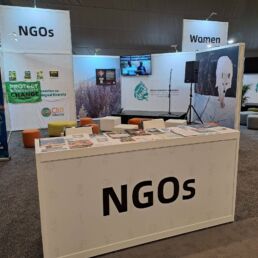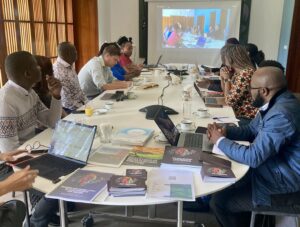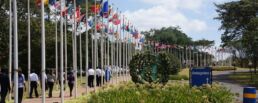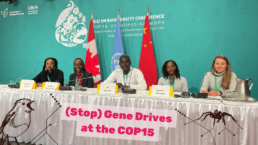Seminar und Pressekonferenz zu Gene Drives in Nairobi
Am heutigen Morgen, Freitag, den 17. Mai, veranstalteten Save Our Seeds in Zusammenarbeit mit Pollinis ein hybrides Seminar über gentechnisch veränderte Organismen (GMOs) und Gene Drives. Diese Veranstaltung bot eine außergewöhnliche Gelegenheit, Einblicke in die politische Landschaft rund um GMOs und das zunehmend umstrittene Thema der Gene Drives zu gewinnen, die derzeit auf der Konvention über die biologische Vielfalt der Vereinten Nationen diskutiert werden. Unsere Expert:innen, frisch aus den jüngsten SBSTTA-Diskussionen, beleuchteten, was während dieser entscheidenden Debatten geschehen ist und was dies für lokale Kontexte bedeutet.
Im Anschluss an das Seminar fand eine Pressekonferenz statt, an der Journalisten aus mehreren afrikanischen Ländern teilnahmen.
 Pressemitteilung (auf englisch)
Pressemitteilung (auf englisch)
UN Body Considers Risky New Genetic Technologies: Civil Society Urges Precaution
Nairobi, Kenya, May 17 2024: Parties to the United Nations Convention on Biological Diversity (CBD) are currently discussing controversial technologies in Nairobi. One such technology is engineered gene drives. It is a form of extreme genetic engineering which is designed to spread its modification throughout an entire species and persist in the environment. In Africa, gene drive projects, largely funded by the Bill and Melinda Gates Foundation, are already underway in several countries including Burkina Faso, Ghana, Uganda and most recently in Tanzania, aiming to eradicate malaria. However, these techno-fixes do not address the root causes of health challenges on the continent and pose novel risks. Furthermore, these projects are proceeding despite the absence of adequate local capacity to assess and regulate them effectively.
While gene drive lobbyists, at the 26th meeting of the Subsidiary Body on Scientific, Technical and Technological Advice (SBSTTA) to the CBD in Nairobi, use the possibility of malaria eradication to promote the technology, civil society organizations have found that most patents are being filed for agricultural use. Patents reference hundreds of agricultural uses, such as for herbicides, pesticides and so called “pests”. Researchers found that agribusiness firms such as Monsanto-Bayer and Cibus Bioscience were also engaging with gene drive development.
At this year’s SBSTTA meeting, member states are examining reports from expert groups, highlighting numerous risks and unanswered questions about gene drives. Discussions are particularly focused on the contrasting potential benefits and risks these technologies might pose. Sub-Saharan countries are advocating for enhanced capacity building, technology transfer, and some seem to be willing to adopt gene drives. African civil society organizations (CSOs) are calling for ongoing evaluations and a robust, updated regulatory framework to manage these technologies. They endorse a precautionary approach and support the establishment of an international expert group to review new technologies before they are introduced to the environment.
Decisions made at SBSTTA will be taken to the Conference of the Parties to the CBD in October 2024 to be further discussed, where heads of states will decide on how to proceed with these technologies.
Contacts:
Sabrina Masinjila
African Centre for Biodiversity
+255 767 089 834
Barbara Ntambirweki
ETC Group Uganda
bntamby@gmail.com
References:
Gene Drive Brochure
Forcing the Farm:
https://www.etcgroup.org/content/forcing-farm
Seminar and Press Conference on Gene Drives in Nairobi
This morning, Friday 17th of May, Save Our Seeds with Pollinis hosted a hybrid seminar on GMOs and gene drives. This event offered an exceptional opportunity to gain insights into the political landscape surrounding GMOs and the increasingly contentious topic of gene drives currently under consideration at the United Nations Convention on Biological Diversity. Our expert speakers, fresh from the recent SBSTTA discussions, shed light on what transpired during those crucial debates and what it means for local contexts.
Following the seminar we hosted a press conference attended by journalists from several African countries.
Press Release
UN Body Considers Risky New Genetic Technologies: Civil Society Urges Precaution
Nairobi, Kenya, May 17 2024: Parties to the United Nations Convention on Biological Diversity (CBD) are currently discussing controversial technologies in Nairobi. One such technology is engineered gene drives. It is a form of extreme genetic engineering which is designed to spread its modification throughout an entire species and persist in the environment. In Africa, gene drive projects, largely funded by the Bill and Melinda Gates Foundation, are already underway in several countries including Burkina Faso, Ghana, Uganda and most recently in Tanzania, aiming to eradicate malaria. However, these techno-fixes do not address the root causes of health challenges on the continent and pose novel risks. Furthermore, these projects are proceeding despite the absence of adequate local capacity to assess and regulate them effectively.
While gene drive lobbyists, at the 26th meeting of the Subsidiary Body on Scientific, Technical and Technological Advice (SBSTTA) to the CBD in Nairobi, use the possibility of malaria eradication to promote the technology, civil society organizations have found that most patents are being filed for agricultural use. Patents reference hundreds of agricultural uses, such as for herbicides, pesticides and so called “pests”. Researchers found that agribusiness firms such as Monsanto-Bayer and Cibus Bioscience were also engaging with gene drive development.
At this year’s SBSTTA meeting, member states are examining reports from expert groups, highlighting numerous risks and unanswered questions about gene drives. Discussions are particularly focused on the contrasting potential benefits and risks these technologies might pose. Sub-Saharan countries are advocating for enhanced capacity building, technology transfer, and some seem to be willing to adopt gene drives. African civil society organizations (CSOs) are calling for ongoing evaluations and a robust, updated regulatory framework to manage these technologies. They endorse a precautionary approach and support the establishment of an international expert group to review new technologies before they are introduced to the environment.
Decisions made at SBSTTA will be taken to the Conference of the Parties to the CBD in October 2024 to be further discussed, where heads of states will decide on how to proceed with these technologies.
Contacts:
Sabrina Masinjila
African Centre for Biodiversity
+255 767 089 834
Barbara Ntambirweki
ETC Group Uganda
bntamby@gmail.com
References:
Gene Drive Brochure
Forcing the Farm:
https://www.etcgroup.org/content/forcing-farm
SBSTTA 26: Urgent need for international biosafety oversight and the right to say no, as gene drive mosquito projects expand in Africa
As participants in the 26th Subsidiary Body on Scientific, Technical, and Technological Advice (SBSTTA 26) of the UN Convention on Biological Diversity (CBD), we will be sharing insights through articles authored by members of the CBD-Alliance’s Working Group on Synthetic Biology, to which we belong.
Key topics of discussion at the Nairobi conference include synthetic biology and the risk assessment of gene drives. For more detailed information on the issues at play, we invite you to consult the briefings (short/long) we have developed in preparation for this conference.
Please find below an article by our partner Sabrina Masinjila from the African Centre for Biodiversity:
Urgent need for international biosafety oversight and the right to say no, as gene drive
mosquito projects expand in Africa
Gene drives, a form of synthetic biology, pose significant risks with their potential to alter entire species, including driving them to extinction. Discussions on gene drives under the Convention of Biological Diversity (CBD) have been extremely contentious, as those with vested interests have been blocking international biosafety regulation and oversight.
Projects like Target Malaria and Transmission Zero (T0) are advancing the deployment of gene-drive mosquitoes, primarily targeting malaria-carrying Anopheles mosquitoes, in both West and East African countries. However, these initiatives have proceeded in the absence of internationally agreed biosafety standards to govern risk assessment and management during the contained use experimental phase as well as open releases.
This is compounded by scant biosafety institutional and regulatory capacity in Africa, a lack of regulatory experience, and no transparency in terms of information, as required by the Cartagena Protocol on Biosafety and national biosafety regulations.
African civil society in Tanzania, for example, where the T0 project operates, have raised concerns about limited wider public consultation and access to pertinent documents.
While malaria is a huge public health challenge in Africa, investments should focus on systemic solutions that provide adequate healthcare, clean water, and sanitation.
Please see ACB’s new blog for more detail: https://acbio.org.za/gm-biosafety/expansion-of-gene-drive-mosquito-projects-in-africa/
Gene drive organisms pose unacceptable risks to biodiversity and human health and the draft guidance for risk assessment developed under the CBD to date is not comprehensive enough to address the uncertainties. Further guidance that invokes the precautionary principle and the right to say no is essential. We strongly urge African governments to support further guidance under the CBD that provides thorough methodologies capable of fully addressing the risks.
SBSTTA 26: Robust risk assessment needed for LMOs containing engineered gene drives
As participants in the 26th Subsidiary Body on Scientific, Technical, and Technological Advice (SBSTTA 26) of the UN Convention on Biological Diversity (CBD), we will be sharing insights through articles authored by members of the CBD-Alliance's Working Group on Synthetic Biology, to which we belong.
Key topics of discussion at the Nairobi conference include synthetic biology and the risk assessment of gene drives. For more detailed information on the issues at play, we invite you to consult the briefings (short/long) we have developed in preparation for this conference.
Please find below an article by our partner Dr Eva Sirinathsinghji from Third World Network:
Robust risk assessment needed for LMOs containing engineered gene drives
The development of living-modified organisms containing engineered gene drives (EGD-LMOs) has raised significant controversy due to their explicit design intention of spread and persistence within wild populations.
The novelties of EGD-LMOs raise fundamental challenges to (i) the ability to assess risk; (ii) the capacity to mitigate or recall them; (iii) the ability to prevent transboundary movement; (iv) assessment of socio-economic impacts; (v) operationalizing mechanisms of obtaining free, prior and informed consent; and (vi) liability and redress.
In decision 14/19, Parties recognized that specific guidance may be useful for the risk assessment of EGD-LMOs and set out precautionary conditions that should be met before any consideration of environmental release. The AHTEG on Risk Assessment has now developed guidance materials, for discussion at SBSTTA-26.
The guidance identifies major risks and uncertainties of EGD-LMOs, including the potential for gene flow to non-target species, the likely inability to isolate or prevent transboundary movement for some EGD-LMOs, and potential serious risks to human health for public health applications.
However, while the guidance provides a starting point, it lacks methodological guidance on how to address the identified risks and uncertainties. There is an overemphasis on describing a new methodology, but not how it can be applied specifically to EGD-LMOs.
Moreover, concerns were raised over a potential conflict of interest involving a member of the AHTEG, and an associated failure by this individual to disclose the relevant situation in accordance with decision 14/33.
We therefore call on Parties to:
- Improve the draft guidance materials and define appropriate modalities to do so
- Ensure the proper application of the procedure for avoiding or managing conflicts of interest, including adopting the amendments set out in CBD/SBI/4/11
- Ensure a wider assessment of the socioeconomic, cultural, and ethical impacts of EGD-LMOs
- Reaffirm the precautionary approach and ensure no release of high-risk and unassessed EGD-LMOs.
SBSTTA 26: Ensuring good governance of synthetic biology
As participants in the 26th Subsidiary Body on Scientific, Technical, and Technological Advice (SBSTTA 26) of the UN Convention on Biological Diversity (CBD), we will be sharing insights through articles authored by members of the CBD-Alliance's Working Group on Synthetic Biology, to which we belong.
Key topics of discussion at the Nairobi conference include synthetic biology and the risk assessment of gene drives. For more detailed information on the issues at play, we invite you to consult the briefings (short/long) we have developed in preparation for this conference.
Please find below an introductory article from the Working Group on Synthetic Biology:
Ensuring good governance of synthetic biology
At the Conference of Parties (COP) 15 of the Convention of Biodiversity, Parties established, in Decision 15/31, a “broad and regular” process of multidisciplinary horizon scanning, assessment and monitoring of new developments in Synthetic Biology. The need for this process was already identified by Parties in Decision 14/19, and provides a means for governments to collaboratively track and provide timely responses to biodiversity threats and opportunities emerging from modern biotechnology developments.
In the past two years, the multidisciplinary Ad Hoc Technical Expert Group (mATHEG) on Synthetic Biology undertook extensive work to design, review and test a working methodology for the broad and regular process. This was reported as Annex IV of CBD/ SBSTTA/26/4. It involves an expert-driven process with multiple steps of information gathering, synthesis, screening, selection, filtration, and analysis.
The mAHTEG identified 5 priority topics for assessment: self-spreading vaccines for wildlife, self- limiting insect systems, development of engineered gene drives to control vector-borne diseases and invasive species, integration of artificial Intelligence and machine learning, and inequity in the participation of developing countries in the context of synthetic biology.
The group undertook a first round of multidisciplinary horizon scanning, monitoring, and assessment for these 5 topics, reported their findings, and articulated proposals for further policy work.
They identified key areas of developments for policy attention, and issued a set of recommendations to the SBSTTA. Read the CBDA Working group on synthetic biology brief on this topic here- https://cbd-alliance.org/en/2024/factsheet-synthetic-biology
Drawing on the work of the mAHTEG, we believe the Parties at SBSTTA 26 should:
- Agree the methodology of the broad and regular process, as outlined and road-tested by the mAHTEG, and confirm that the process should occur at least each biennium (ie; between every COP).
- Re-emphasize the importance of multidisciplinarity and precaution to the functioning of the broad and regular process.
- Initiate timely policy formulation processes on priority topics identified by the mAHTEG, including 1. The Integration of Artificial Intelligence (AI) with synthetic biology and 2. Self- spreading vaccines for wildlife.
- Request that assessment guidelines on gene drives also incorporate socioeconomic, cultural, and ethical impacts.
- Address other topics raised by the mAHTEG: including issues of North-South equity, self- limiting insects, technology facilitation, and capacity-building for horizon scanning, assessment and monitoring activities.
- Ensure no release of high risk and unassessed synthetic biology organisms, components, or products takes place.
World Malaria Day 2023 and the gene drives deception
World Malaria Day 2023 and the gene drives deception
At the occasion of World Malaria Day (25 April), the Stop Gene Drives Campaign encourages you to take a closer look at the insights and perspectives shared by prominent actors and other organisations closely monitoring the subject on this significant day.
By 2030, the World Health Organization (WHO) hopes to reduce the global malaria burden by ninety percent (in comparison to a 2015 baseline). Running against the clock, facing unforeseen obstacles, and with multiple interests on the table, recent years have seen setbacks in the progress of malaria control.
Particularly during the Covid-19 pandemic, health service disruptions, diverted resources, and reduced access to affected communities posed concrete obstacles towards the 2030 target.
Aiming at overcoming such obstacles and accelerating the process, the 2023 World Malaria Day was marked by the theme “Time to deliver zero malaria: invest, innovate, implement”. On social media and online, this slogan was well exploited to reinforce a narrative in which biotechnology (particularly gene drives) is the pinnacle of innovation in malaria control.
We invite you to look at a few examples and join us in uncovering the stories behind them.
A new type of celebrity
Target Malaria, a controversial research consortium backed by US military funding from DARPA, took the opportunity to reinforce its narrative of innovation equals solution.
In their story, scientists are the equivalent of rockstars, who will use their latest creations to save the world from malaria. They insist that urgent innovation (i.e. new genetic technologies, particularly gene drives to eradicate mosquitos) is the only viable remedy in the face of the critical situation. This scenario, in their view, seems to exist is a vacuum where risks are minimal and negative consequences are not taken into account. Other organisations followed a similar recipe of presenting ‘science and innovation’ as the (only) tools that can put malaria control back on track. (See examples here, here and here)
This tunnel-vision narrative is dangerous and deceptive. In addition to spreading misinformation, efforts that are led by pressure to produce immediate results and return on investment, can easily overlook risks, produce flawed results, and only address issues at surface level. In addition to that, it creates momentum towards a false idea that a final solution to the malaria burden has been found – which is unfortunately still not a reality.
A deep wound cannot be treated with a bandage
Fighting malaria is a complex issue that requires structural and long-term solutions. The push for the deployment of technologies (such as gene drives) ignores both ecological risks and context-related challenges.
At the occasion of World Malaria Day 2023, several organisations and actors raised concerns about why it is crucial to go beyond the superficial, quick-fix/technical aspect of fighting malaria.
The most recurrent concerns highlighted the need to also fight socio-economic and infrastructural factors that enable the prevalence of malaria. These include poverty, gender and other inequalities, inadequate water, sanitation, and hygiene infrastructure, and lack of access to education and healthcare.
Some argue that every malaria case is preventable and avoidable, urging global leaders to increase funding and action. They promote different tools such as enhanced bed nets, vaccines, monoclonal antibodies, and mosquito sugar baits. Advocating for a holistic approach that provides communities with necessary tools and addresses underlying causes. (See examples here, here, and here)
What else is there to uncover?
There seems to be a consensus among those engaged in eradicating malaria that progress towards a dramatic reduction by 2030 is delayed. In this context, narratives that advocate for rushed ‘innovation’ and new technologies as the solution tend to overlook risks and potential irreversible ripple effects.
The emergency of new challenges, such as the detection of a new malaria vector in Sub-Saharan Africa, highlights the importance of carefully considering whether technofixes can soon become obsolete. This is in addition to being sensitive to the myriad of cascading effects that the deployment of an unpredictable and irreversible technology could have in ecosystems and human health.
Research aimed at malaria eradication should be conducted with caution and responsibility as well as be based on serious and accurate scientific methods and findings. Furthermore, it should explore multiple solutions and alternatives (e.g., nets, antimalarial drugs, vaccine, etc.) and not exist in isolation from its context. All efforts to reduce the malaria burden need to consider and address the underlying socio-economic and infrastructural factors that contribute to its prevalence.
Finally, breaking down the narratives and stories being communicated on the topic can be helpful to uncover hidden agendas and identify oversights in the evaluation of tools and methods to eradicate malaria. Hopefully, contributing to a more adequate and informed evaluation of options and balanced and responsible decision-making in fighting malaria.
Further resources:
Learn more here about the applications and risks of gene drives in the context of malaria eradication.
Access here the African Center for Biodiversity’s analysis on the linkages between capitalism and malaria.
Watch here an interview with Burkinabé activists Ali Tapsoba and Guy Yameogo assessing community engagement for gene drive release in their country.
Access here some insights from front line workers on the issue of gene drives and malaria.
Welt-Malaria-Tag 2023 und die Gene Drives - Enttäuschung
Welt-Malaria-Tag 2023 und die Gene Drives – Enttäuschung
Anlässlich des Welt Malaria Tages, der jedes Jahr am 25. April stattfindet, lädt die Stop Gene Drives Kampagne dazu ein, einen genaueren Blick auf die Botschaften derer zu werfen, die zu diesem Thema arbeiten.
Die Weltgesundheitsorganisation (WHO) arbeitet daran, die weltweite Malariabelastung bis zum Jahr 2030 um neunzig Prozent zu reduzieren (im Vergleich zu einer Ausgangsbasis von 2015). Angesichts des Wettlaufs gegen die Zeit, unvorhergesehener Hindernisse und vielfältiger Interessen gab es in den letzten Jahren Rückschläge bei der Malariabekämpfung.
Insbesondere während der Covid-19-Pandemie stellten Unterbrechungen der Gesundheitsdienstleistungen, verlagerte Ressourcen und ein eingeschränkter Zugang zu den betroffenen Gemeinschaften konkrete Hindernisse auf dem Weg zum Ziel für 2030 dar.
Mit dem Ziel, solche Hindernisse zu überwinden und den Prozess zu beschleunigen, stand der Weltmalariatag 2023 unter dem Motto „Zeit für Null Malaria: investieren, innovieren, umsetzen„. In den sozialen Medien und im Internet wurde dieser Slogan geschickt genutzt, um die Biotechnologie (insbesondere Gene Drives) als den Gipfel der Innovation in der Malariabekämpfung darzustellen.
Wir laden Sie ein, sich einige Beispiele anzuschauen und gemeinsam mit uns die Geschichten dahinter zu entdecken.
Eine neue Art von Berühmtheiten
Target Malaria, ein umstrittenes Forschungskonsortium, das vom US-Militär finanziert wird (DARPA), nutzte die Gelegenheit, um sein Narrativ von „Innovation gleich Lösung“ zu untermauern.
In ihrer Erzählung sind die Wissenschaftler:innen das Äquivalent zu Rockstars, die mit ihren neuesten Kreationen die Welt vor Malaria retten sollen. Sie beharren darauf, dass dringende Innovationen (d. h. neue Gentechnologien, insbesondere Gene Drives zur Ausrottung von Moskitos) angesichts der kritischen Situation das einzig brauchbare Mittel sind. Dieses Szenario scheint ihrer Ansicht nach in einem Vakuum zu existieren, in dem die Risiken minimal sind und die negativen Folgen nicht berücksichtigt werden. Andere Organisationen folgten einem ähnlichen Rezept, indem sie „Wissenschaft und Innovation“ als die (einzigen) Instrumente darstellten, die die Malariabekämpfung wieder in Gang bringen können. (Siehe Beispiele hier, hier und hier)
Dieser Tunnelblick ist gefährlich und trügerisch. Abgesehen von der Verbreitung von Fehlinformationen können Bemühungen, die unter dem Druck stehen, sofortige Ergebnisse zu erzielen und sich zu finanziell zu lohnen, leicht Risiken übersehen, fehlerhafte Ergebnisse liefern und Probleme nur oberflächlich angehen. Darüber hinaus wird dadurch die falsche Vorstellung erzeugt, dass eine endgültige Lösung in der Malariabekämpfung gefunden wurde – was nicht der Fall ist.
Kein Pflaster kann eine tiefe Wunde heilen
Malariabekämpfung ist ein komplexes Anliegen, welches strukturelle und langfristige Lösungen erfordert. Das Drängen auf den Einsatz von Technologien (wie Gene Drives) ignoriert sowohl ökologische Risiken als auch kontextbezogene Herausforderungen.
Anlässlich des Welt-Malaria-Tags 2023 haben mehrere Organisationen und Akteur:innen darauf hingewiesen, warum es wichtig ist, bei der Malariabekämpfung über den oberflächlichen, technischen Aspekt hinauszublicken.
Die am häufigsten geäußerten Bedenken unterstrichen die Notwendigkeit, auch die sozioökonomischen und infrastrukturellen Faktoren zu bekämpfen, die das Auftreten von Malaria begünstigen. Dazu gehören Armut, geschlechterspezifische und andere Ungleichheiten, unzureichende Wasser-, Sanitär- und Hygieneinfrastruktur sowie mangelnder Zugang zu Bildung und der Gesundheitsversorgung.
Einige argumentieren, dass jeder Malariafall vermeid- und abwendbar ist, und fordern führende Politiker:innen weltweit auf, mehr Mittel bereizustellen und Maßnahmen zu ergreifen. Sie befürworten verschiedene Methoden wie verbesserte Moskitonetze, Impfstoffe, monoklonale Antikörper und Moskitozuckerköder. Sie plädieren für einen ganzheitlichen Ansatz, der den Gemeinden die notwendigen Mittel an die Hand gibt und die Ursachen bekämpft. (Siehe Beispiele hier, hier und hier)
Was gibt es noch aufzudecken?
Unter denjenigen, die in der Malariabekämpfung aktiv sind, scheint es einen Konsens darüber zu geben, dass sich die Fortschritte auf dem Weg zu einer drastischen Reduzierung bis 2030 verzögern. In diesem Zusammenhang übersehen Stimmen, die für überstürzte „Innovationen“ und neue Technologien als Lösung plädieren, oft die Risiken und potenziellen irreversiblen Auswirkungen.
Das Auftreten neuer Herausforderungen, wie die Entdeckung eines neuen Malariavektors in Afrika südlich der Sahara, macht deutlich, wie wichtig es ist, sorgfältig zu prüfen, ob technologische Lösungen bald überholt sein könnten. Darüber hinaus muss man sich der unzähligen Kaskadeneffekte bewusst sein, die der Einsatz einer unvorhersehbaren und irreversiblen Technologie für die Ökosysteme und die menschliche Gesundheit haben könnte.
Forschung zur Malaria-Ausrottung sollte mit Vorsicht und Verantwortungsbewusstsein betrieben werden und auf seriösen und genauen wissenschaftlichen Methoden und Erkenntnissen beruhen. Darüber hinaus sollte sie mehrere Lösungen und Alternativen (z. B. Netze, Malariamedikamente, Impfstoffe usw.) untersuchen und nicht losgelöst von ihrem Kontext existieren. Alle Bemühungen die Belastung durch Malaria zu verringern müssen die zugrundeliegenden sozioökonomischen und infrastrukturellen Faktoren, die zur Verbreitung von Malaria beitragen, berücksichtigen und angehen.
Schließlich kann es hilfreich sein, die Erzählungen und Geschichten, die zu diesem Thema kommuniziert werden, aufzuschlüsseln, um versteckte Absichten aufzudecken und Schwachstellen bei der Bewertung von Instrumenten und Methoden zur Ausrottung von Malaria zu erkennen. Dies trägt hoffentlich zu einer angemesseneren und sachkundigeren Bewertung der Optionen und zu einer ausgewogenen und verantwortungsvollen Entscheidungsfindung im Kampf gegen Malaria bei.
Zum Weiterlesen und Schauen:
Erfahren Sie mehr über die Anwendungen und Risiken von Gene Drives im Zusammenhang mit der Ausrottung von Malaria.
Lesen Sie die Analyse des African Center for Biodiversity über die Zusammenhänge zwischen Kapitalismus und Malaria.
Die beiden burkinabischen Aktivisten Ali Tapsoba und Guy Yameogo, erzählen in diesem Video, wie die Bevölkerung in ihrem Land zur Freisetzung von Gene Drives steht.
Hier finden Sie einige Interviews von Expert:innen die jeden Tag mit Malaria zu kämpfen haben.
Was geschah mit Gene Drives bei der COP15 der UN-Konvention über die biologische Vielfalt?
Was geschah mit Gene Drives bei der COP15 der UN-Konvention über die biologische Vielfalt?
Im Dezember 2022 versammelten sich Staaten aus aller Welt im verschneiten Montreal, um über den Schutz und die Erhaltung der biologischen Vielfalt bis 2030 zu verhandeln. Was hatten sie über neue Technologien wie Gene Drives zu sagen?
Das Rahmenwerk zur Erhaltung der biologischen Vielfalt für die Zeit nach 2020 (Post-2020 Biodiversity Framework, GBF) wurde oft als „Durchbruch“ bezeichnet, um den Verlust der biologischen Vielfalt aufzuhalten. Doch die Diskussionen und Entscheidungen in Montreal zu synthetischer Biologie hinterließen bei vielen zivilgesellschaftlichen Organisationen, wie der Stop Gene Drives Kampagne, einen bitteren Nachgeschmack.
Biotechnologie-Giganten wie Brasilien und Argentinien verhandelten hartnäckig, um jegliche Erwähnung des Vorsorgeprinzips und der Risikobewertung aus allen Texten zu streichen. Stattdessen wurde beharrlich, wo immer es möglich war, das Dogma der „Innovation“ hineingeschrieben. Somit bleibt der Welt nach fünf Arbeitsgruppen (Open Ended Working Groups) im Laufe von drei Jahren und zwei Wochen COP15-Diskussionen ein Ziel 17 zur Biotechnologie, das nichts weiter tut, als die CBD-Konvention von 1992 zu zitieren. Zwei der Unterhändler an den Verhandlungstischen in Montreal witzelten darüber, dass sie in der Zeit geboren wurden und illustrierten damit wie sich die Welt der Biotechnologie seit 1992 weiterentwickelt hat. Leider scheint der neue Post-2020-Rahmen für die biologische Vielfalt nicht mit dieser Entwicklung Schritt zu halten.
In Montreal lief jedoch nicht alles schlecht. Neben der Verabschiedung des Post-2020 GBF gelang es der COP15, eine neue multidisziplinäre technische Ad-hoc-Expert:innengruppe für Horizon Scanning, Überwachung und Technologiebewertung der synthetischen Biologie anzuberaumen. „Fachleute aus einem breiten Spektrum wissenschaftlicher Disziplinen sowie interdisziplinäres und interkulturelles Fachwissen, indigene Völker und lokale Gemeinschaften“ sollen in den Prozess einbezogen werden.
Ein weiterer erfreulicher Aspekt ist, dass die Resolution der COP14 zu Interessenkonflikten Anwendung finden wird, um die wissenschaftliche Integrität und Unabhängigkeit der Expert:innengruppen zu gewährleisten. Diese Resolution entstand nachdem die Gene Drives Files (= publik gemachte Dokumente, die aufzeigen, dass die Bill and Melinda Gates Foundation eine Public-Affairs-Firma aus der Agrarindustrie finanziert hat, um im Rahmen der CBD einen Expert:innenprozess verdeckt zu beeinflussen, damit GDOs nicht reguliert werden) enthüllt wurden. Dies ist ein Versuch, die Teilnahme von so genannten „unabhängigen“ Wissenschaftler:innen, die im Auftrag von Philanthropen und Milliardären handeln, in CBD-Expert:innengruppen einzuschränken.
Parallel zur COP15 wurde die elfte Konferenz der Vertragsstaaten des Cartagena-Protokolls (CP-MOP 10) abgehalten. Dieses Protokoll regelt Fragen der biologischen Sicherheit. Gene Drives stellen im Vergleich zu den „klassischen“ gentechnisch veränderten Organismen, die unter das Protokoll fallen, neue, unbekannte Herausforderungen dar. Dementsprechend wurde in Montreal eine technische Ad-hoc-Expert:innengruppe beauftragt zusätzliche Leitlinien für die Risikobewertung und das Management von Gene-Drive-Organismen zu erarbeiten.
Der Schwerpunkt dieser Gruppe wird auf Gene-Drive-Mücken liegen, da bei ihnen die Entwicklung von Gene-Drives bisher am weitesten fortgeschritten ist. Diese Leitfäden sind freiwilliger Natur, werden aber dazu beitragen, die Risikobewertung weltweit zu verbessern und hoffentlich offene Fragen, Bedenken und Herausforderungen in Bezug auf die Auswirkungen von Gene Drives auf die Umwelt aufdecken.
Was liegt vor uns?
Die nächsten ein bis zwei Jahre sind entscheidend für die (multidisziplinären) technischen Expert:innengruppen, die Biotechnologien wie Gene Drives untersuchen und an Leitlinien arbeiten. In der Zwischenzeit können Regierungen und ihre Institutionen, indigene Völker und lokale Gemeinschaften sowie Organisationen der Zivilgesellschaft Informationen einreichen, die von den Expert:innengruppen berücksichtigt werden sollen. Diese Akteur:innen können sich auch direkt an Online-Foren beteiligen, um ihre Bedenken und offenen Fragen zur synthetischen Biologie und zu Gene Drives vorzubringen.
Auf der nächsten COP (16) in der Türkei werden die Staaten darüber diskutieren, ob der Prozess des Horizon Scanning und der Technologiebewertung fortgesetzt werden soll. Außerdem werden sie die Indikatoren vorstellen, mit denen die Fortschritte bei der Erreichung von Ziel 17 gemessen werden sollen. Wir sind gespannt, wie die „erfolgreiche“ Verwirklichung dieses Ziels gemessen wird und für welche Art von Maßnahmen die Regierungen eine Finanzierung erhalten können.
Kurz gesagt, es gibt zwei Möglichkeiten: Entweder könnte die UN CBD weiterhin Risikobewertungen für neue Technologien wie Gene Drives fordern, um alle Auswirkungen auf die biologische Vielfalt messen zu können; oder der Prozess wird abgekürzt, und es wäre keine Risikobewertung von Gene Drives mehr gewährleistet.
Wenn es um Gene Drives im Rahmen des Cartagena-Protokolls geht, hoffen wir, dass der Prozess wahrhaftig dazu beiträgt, die nationalen Regierungen besser für die Risikobewertung von Gene Drives zu rüsten.
Weitere COP bezogene Posts/Artikel der Stop Gene Drives Kampagne:
ECO Artikel während der COP15 (auf Englisch):
01.12.2022 Gene drives are the opposite of nature conservation
05.12.2022 Ecuador’s Galápagos Islands are not a laboratory for testing risky gene drive organisms
07.12.2022 All CBD watchdogs should guard against synthetic biology threats to biodiversity
10.12.2022 Brazilian intransigence on biotech is a violation of human rights
18.12.2022 Snowman to snow-mess: negotiations at COP15 are opening doors to risky technologies
Blogpost im Vorfeld der COP15 (auf Englisch):
Gene drives are the opposite of nature conservation



What happened to Gene Drives at COP15 of the UN Convention on Biodiversity?
What happened to Gene Drives at COP15 of the UN Convention on Biodiversity?
In December 2022, States from all around the world gathered in snowy Montreal to discuss the future of biodiversity protection and conservation until 2030. What did they have to say about new technologies such as gene drives?
The Post-2020 Biodiversity Framework (GBF) has been often referred as a ‘breakthrough’ to halt biodiversity loss. However, the discussions and decisions made in Montreal left synthetic biology watchdogs, like the Stop Gene Drives Campaign, with a bitter aftertaste of corporate influence.
Biotechnology giants such as Brazil and Argentina strongly negotiated to remove any mentions to the precautionary principle and risk assessment from all texts. There was also persistence in inserting the dogma of ‘innovation’ wherever possible. After five Open Ended Working Groups over the course of three years and two weeks of COP15 discussions, the world is left with a Target 17 on Biotechnology that does not do anything beyond reiterating the CBD Convention of 1992. One clear sign that the world of biotechnology has evolved since 1992 is that some of the negotiators sitting at the table today were born in that year. Unfortunately, the new Post-2020 Biodiversity Framework does not seem to keep up with it.
In good time, not all was gloom in Montreal. In addition to adopting the GBF, COP15 managed to set up a new multidisciplinary Ad-Hoc Technical Expert Group for horizon scanning, monitoring and technology assessment of synthetic biology. “Expertise from a broad range of scientific disciplines, as well as interdisciplinary and intercultural expertise, indigenous peoples and local communities” will be included in the process.
Another constructive aspect of the decision is that the conflict of interest resolution from the COP14 will apply, aiming to ensure the scientific integrity and independence of the work of expert groups. It builds on harmful past experiences revealed in the Gene Drives Files (= documents obtained under the US freedom of information provisions showing that the Bill and Melinda Gates Foundation financed an agribusiness public affairs firm to covertly skew an expert process under the CBD in order to lobby against the regulation of GDOs). This is an attempt to confine so called ‘independent’ scientist acting on behalf of philanthropists and billionaires in CBD expert groups.
When it comes to the particular issue of gene drives, the most relevant decision was taken at the meeting of the Parties to the Cartagena Protocol (CP-MOP 10). This Protocol manages biosafety matters. Gene Drives present new uncharted challenges in comparison to ‘classic’ Genetically Modified Organisms covered by the Protocol. Accordingly, an Ad-Hoc Technical Expert Group was established in Montreal to develop additional guidance materials on risk assessment and management of gene drive organisms. Important to note: without the ‘m’ of multidisciplinary.
The focus area of this group will be gene drive mosquitoes, as for them gene drives have been furthest developed to date. These guidance materials will be of voluntary nature, but will help to inform risk assessment globally and, hopefully, unveil open questions, concerns and challenges regarding impacts of gene drives on the environment.
What lies ahead?
The next one to two years are decisive for the (multidisciplinary) technical expert groups scanning biotechnologies like gene drives and working on guidance materials. In the meantime, governments and their institutions, Indigenous Peoples and Local communities, and civil society organizations can submit information to be considered by the expert groups. These actors can also directly participate in online forums to raise their concerns and open questions on synthetic biology and gene drives.
At the next COP (16) in Turkey, States will discuss whether the process of horizon scanning and technology assessment should be continued. They will as well present the indicators that will help to measure the progress of reaching Target 17. We are curious to see how the ‘successful’ attainment of that Target will be measured and for what sorts of projects governments will be eligible for funding.
In short, this means two broad possibilities. On the one hand, the UN CBD could continue requesting risk assessment of new technologies such as gene drives in order to be able to measure all their impacts on biodiversity. On the other hand, the process can be cut short and no risk assessment would be guaranteed.
Finally, when it comes to gene drives under the Cartagena Protocol we hope that the process will genuinely work towards better equipping national governments for risk assessment of gene drives.
At the Stop Gene Drives campaign, we believe that a thorough and holistic risk assessment of gene drives will further expose that current levels of scientific understanding are not sufficient to predict their (irreversible) potential impacts. This would bring yet more clarity on why the release of gene drives into the environment is incompatible with the objectives of the Convention and its Protocols.
Further COP related posts/articles by the Stop Gene Drive Campaign:
ECO articles during the COP15:
01.12.2022 Gene drives are the opposite of nature conservation
05.12.2022 Ecuador’s Galápagos Islands are not a laboratory for testing risky gene drive organisms
07.12.2022 All CBD watchdogs should guard against synthetic biology threats to biodiversity
10.12.2022 Brazilian intransigence on biotech is a violation of human rights
18.12.2022 Snowman to snow-mess: negotiations at COP15 are opening doors to risky technologies
Blogpost leading up to the Conference:
Gene drives are the opposite of nature conservation



Gene drives are the opposite of nature conservation
Civil society organisations around the globe demand a moratorium on genetically engineered gene drives at UN Biodiversity Conference
Berlin, 1 December 2022 – Ahead of the UN Biodiversity Conference COP 15 and its Cartagena Protocol on Biosafety in Montreal over 140 civil society organisations from Africa, Asia, Europe, Australia and the Americas have issued a joint manifesto exposing alarming risks of environmental releases of genetically engineered gene drive organisms which could lead to irreversible ecological consequences and drive entire species into extinction.
Gene drives use new genetic engineering techniques such as CRISPR-Cas to forcibly spread new genetic information within the genome of populations and entire species of organisms in nature, including traits that can cause their extinction. The signatories of the manifesto are urging national governments at COP15 to resolve critical legal, environmental, biosafety and governance issues as well as fundamental ethical and cultural questions before considering any environmental release of gene drive organisms.
The call for a global moratorium is consistent with demands at previous occasions including at COP13 in Cancun and COP14 in Sharm El-Sheikh. „This controversy will not go away“, said Barbara Pilz, who coordinates the international Stop Gene Drives campaign. „We will continue to fight for a global moratorium on this pretentious concept of reprogramming and extincting entire species in nature.“
The manifesto highlights the need for thorough and genuine risk assessment and uncovers the lack of participatory decision-making processes on this topic to date. It proposes the inclusion of multi-disciplinary expertise and respect for diverse knowledge systems in any processes of technology assessment involving gene drives. This should include indigenous peoples and local communities whose territories are among those being proposed for the first releases of gene drive organisms.
Recalling the goals of the UN Convention on Biological Diversity, Pilz added:
„We urge decision makers at COP15 to approach the issue of gene drives with utmost caution. Once released, they cannot be controlled, reversed or recalled and will respect no borders. This technology adds immense risks to the conservation of biological diversity and is at odds with the concept of nature protection. Let us not create another destructive legacy to future generations. ”
Representatives of the Stop Gene Drives campaign and of other signatories of the manifesto will attend the events of the Convention on Biological Diversity in person in Montreal this December and can be reached for comment. They will join other strong civil society voices striving for inclusive and participatory processes of precautionary technology assessment and equitable decision making on the subject of synthetic biology and gene drives.
The full text of the manifesto is available here and it is still open for signature.
Contact details in Montreal:
Naomi Kosmehl (Public Relations Lead) – kosmehl@saveourseeds.org
Barbara Pilz (Campaign Manager) – pilz@saveourseeds.org
Phone number: +49 152 23 678426
Further links:
Brochure – Gene Drive Organisms. A New Dimension Of Genetic Engineering: Applications, Risks and Regulation.
Video interview series – Worldwide: Experts on Gene Drives.


 Pressemitteilung (auf englisch)
Pressemitteilung (auf englisch)




